Request: Aloe vera
Request Type: Unique Addition (specific to a build, region, or culture)
Describe the use of this block in said build, region, or culture. How is it unique? To the best of your knowledge how could it be used in a different context?
Types of evidence to support your request: Historical
Historical Evidence
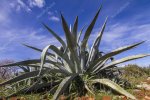

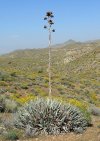
These are all Agave, commonly mistaken as Aloe
Request Type: Unique Addition (specific to a build, region, or culture)
Describe the use of this block in said build, region, or culture. How is it unique? To the best of your knowledge how could it be used in a different context?
As a way to spice up the landscapes of the southermost regions of Westeros, I think adding more plants specific to that area really helps. Some can be easily done with our current blocks, but others simply just can't. Aloe vera is one of them. It's native to the south east of the Arabian Peninsula, though it has expanded its range way beyond that. Currently, it has been naturalized in the shores of the Mediterranean, Macaronesia and more. I would suggest adding a CTM set. Here there's a shitty drawing of what I'm imagining.

For those interested I will make this a NFT starting at 10000€
I would also suggest that it has biome dependancy: In mushroom island biome it should have green leafs, while in desert biome it should have brownish-red leafs. Aloes become that colour when exposed to high levels of sun. I have pictures of both colours linked below. In the rest of the biomes i don't think its looks matter all that much, probably it should stick to its mushroom biome appearance.

For those interested I will make this a NFT starting at 10000€
I would also suggest that it has biome dependancy: In mushroom island biome it should have green leafs, while in desert biome it should have brownish-red leafs. Aloes become that colour when exposed to high levels of sun. I have pictures of both colours linked below. In the rest of the biomes i don't think its looks matter all that much, probably it should stick to its mushroom biome appearance.
Types of evidence to support your request: Historical
Historical Evidence
Aloe vera has been used as a cosmetic and medicinal plant since at least 4000 BCE, been known and used by ancient egyptians, summerians, romans, greeks and many others. Its widespread use along the Mediterranean, however, came later in time, around the 17th century, probably related to cultivation.
One important note: do not mistake Aloe Vera with Agave, a New World plant most know for been the source of mezcal and tequila. They may seem similar in appearance, but there are several key diferences. It's easy to mix them up (I've made that mistake before), specially since Agave is naturalized in the Mediterranean, and appears on cliffs and coast all over.
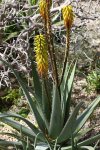
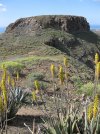
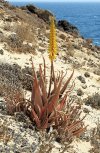
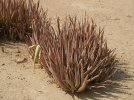
Green and brown aloe, both the same spieces, but reacting to different levels of sun exposure
Unlike Aloe, Agave has flatter and wider leafs, usually with a grey-blue tone, or with stripes. They are also stiffer and when cut they lack the gelatinous texture of Aloe. Agaves tend to grow bigger than Aloes. The main difference its the inflorescence: Aloes have a conical shaped cluster of flowers that range for greenish yellow to orange-red and grow from stems that start at the middle of the plant. Agaves sprout a way bigger inflorescence made of yellow flowers in "disks" that grow out of a central thick stem, resembling almost a tree.

Aloe vera (left) next to a variegated (striped) Agave (right) in CreteOne important note: do not mistake Aloe Vera with Agave, a New World plant most know for been the source of mezcal and tequila. They may seem similar in appearance, but there are several key diferences. It's easy to mix them up (I've made that mistake before), specially since Agave is naturalized in the Mediterranean, and appears on cliffs and coast all over.




Green and brown aloe, both the same spieces, but reacting to different levels of sun exposure
Unlike Aloe, Agave has flatter and wider leafs, usually with a grey-blue tone, or with stripes. They are also stiffer and when cut they lack the gelatinous texture of Aloe. Agaves tend to grow bigger than Aloes. The main difference its the inflorescence: Aloes have a conical shaped cluster of flowers that range for greenish yellow to orange-red and grow from stems that start at the middle of the plant. Agaves sprout a way bigger inflorescence made of yellow flowers in "disks" that grow out of a central thick stem, resembling almost a tree.




These are all Agave, commonly mistaken as Aloe






